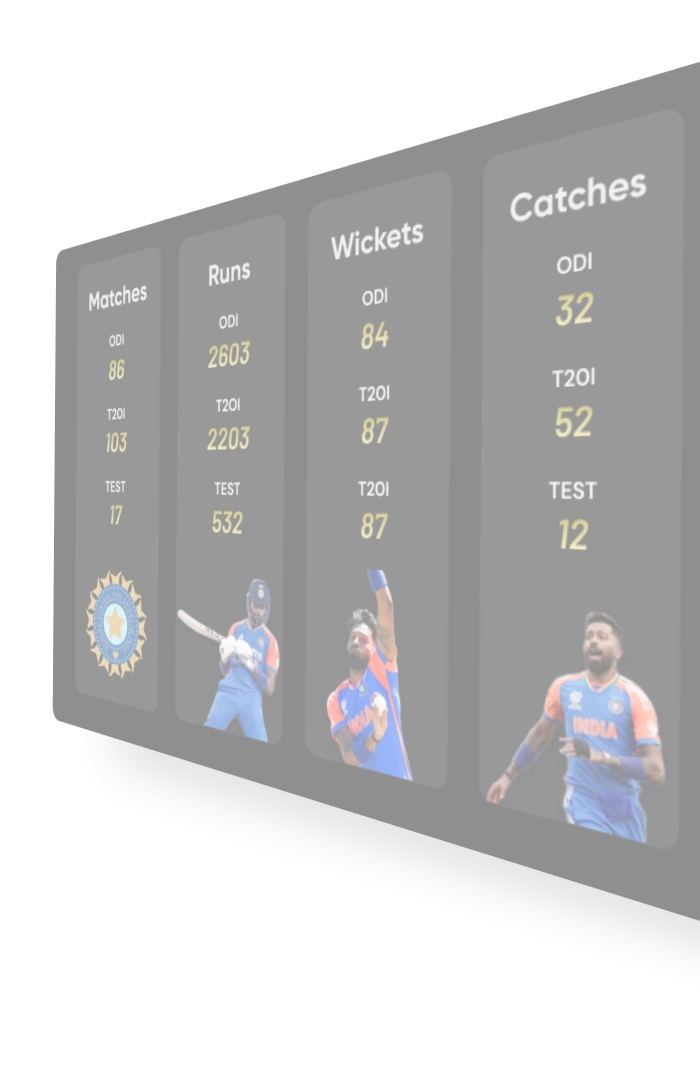
Shahid Afridi, known as "Boom Boom," redefined dangerousness with his fearless, explosive batting style. His technique was raw and unorthodox—relying on brute power and impeccable timing rather than textbook precision—making him a bowler’s nightmare. He was named the Player of the Tournament in the inaugural T20 World Cup in 2007 while ending up on the losing side in the finals against India. However, two years later, Afridi with his all-round performances in the semi-finals and finals won Pakistan their only T20 World Cup title. While he is mostly remembered for his multiple retirement reversals, Afridi bid goodbye to international cricket as one of the most fearsome batters with a strike rate that might never be overtaken.
David Warner’s dangerousness lies in his relentless aggression and versatility across formats. A compact left-hander, his technique blends power with precision, using a low stance to unleash ferocious cuts, pulls, and lofted drives. He was also Australia’s top run-getter in the 2021 T20 World Cup where he scored almost 300 runs at a strike rate of 146. Among his World Cup heroics, Warner is also infamously known for his involvement in the ball-tampering scandal of 2018. Making a comeback after serving a one-year ban, Warner returned with great form scoring 647 runs in the 2019 World Cup. In the IPL, he has been arguably the most consistent overseas batter. In the 2021 T20 World Cup, his 289 runs at a 146 strike rate earned him Player of the Tournament honors, showcasing his ability to decimate attacks under pressure. His IPL consistency—six consecutive 500+ run seasons—highlights a ruthless opener who thrives on intimidating bowlers.


MS Dhoni’s, the finisher dangerous batsman, stems from his ice-cool temperament and unorthodox power-hitting, making him the ultimate finisher. His helicopter shot—a wristy, whip-like aerial drive—became a weapon against pace and spin alike, famously used to seal the 2011 World Cup with a six. His ability to finish matches can be perfectly captured by Ian Bishop’s quote on him. Bishop said, “If 15 runs are needed in the final over then the pressure is on the bowler not on MS Dhoni.” He would go on to finish multiple matches with a six in his career after the 2011 World Cup. MS Dhoni is the best captain in IPL history having played 10 finals as a captain and winning five of them. MS is one of the most dangerous batsman in top 10 dangerous batsman in the world list. Dhoni’s ability to read the game and accelerate at will was showcased in his 183* off 145 balls against Sri Lanka in 2005, the highest score by a wicketkeeper in ODIs at the time. Batting lower down, he combined brute strength with a calm demeanor, often turning hopeless chases into victories. In IPL 2018, his 70* off 34 balls against RCB, with a flurry of sixes, underlined his knack for dismantling bowlers in the death overs, a trait that made him a feared clutch performer.
Kieron Pollard’s towering presence and brute force make him a destructive force, especially in T20s. His technique is built on raw power—standing tall, he launches massive sixes with a high follow-through, often clearing stadiums. His 6 sixes in an over off Akila Dananjaya in a 2021 T20I, joining an elite club with Yuvraj Singh and Herschelle Gibbs, showcased his ability to obliterate spin. He had already shown promise playing in T20 leagues. The huge West Indian all-rounder repaid the faith shown in him by MI by often winning them matches single-handedly. His 87* off 34 balls for Mumbai Indians against CSK in 2021, chasing 219, turned a lost cause into a thriller, underlining his match-winning explosiveness and fearless approach against any bowler.


Brendon McCullum’s dangerousness came from his audacious, attacking style, redefining opener roles across formats. His crouched stance and quick hands unleashed scoop shots and lofted drives, terrorizing bowlers from ball one. His 158* off 73 balls in IPL’s inaugural match in 2008, with 13 sixes, set the tone for T20 cricket’s aggression. However, the wicketkeeper batter was a great batter against the red ball as well. He is the only player from New Zealand to score a triple-century. He achieved the feat while playing for almost 13 hours against India. In IPL, McCullum was one of the torch-bearers of the tournament’s success. His 188 strike rate in the 2015 World Cup, smashing 17 sixes, showcased a fearless approach that made him a pioneer of modern destructive batting.


Adam Gilchrist’s dangerousness was his ability to dominate as a wicketkeeper-batter with a simple yet devastating “see ball, hit ball” philosophy. His upright stance and powerful square cuts and lofted drives made him a terror, especially at No. 7 in Tests. While he was not the sharpest behind the stumps there were very few who could do what he did in front of the stumps. Batting at number 7 in test cricket, no one scored more runs than Gilchrist. He would often deflate the bowling attacks who had toiled hard enough to take five wickets to see him walking at number 7. His 100 Test sixes as a lower-order batter highlight a relentless aggression that redefined the keeper’s role.
Sanath Jayasuriya’s dangerousness revolutionized ODI batting with his explosive, pinch-hitting style as an opener. His low stance and ferocious square cuts and lofted shots over cover dismantled attacks in the powerplay. During the first few years of his career, Jayasuriya played as a bowler who could bat a bit. However, once he started to open the innings for Sri Lanka there was no looking further at other options. While he failed in the knockouts of the 1996 ODI World Cup, Jayasuriya was the player of the tournament as Sri Lanka won their only ODI World Cup. Jayasuriya’s 189 off 161 balls against India in 2000, with 21 fours and 7 sixes, remains one of ODI’s most brutal knocks, cementing his legacy as a bowler-destroying pioneer.


AB de Villiers, dubbed “Mr. 360,” one of the dangerous batsman in the world with his innovative, all-angle batting. His supple wrists and athletic stance birthed shots like the reverse scoop and ramp over the keeper, leaving bowlers clueless. De Villiers’ 278* off 418 balls against Pakistan in 2010 proved his Test-match tenacity, while his 133* off 59 balls for RCB in IPL 2015, with 19 fours and 4 sixes, underlined his T20 dominance. His versatility and unpredictability made him a bowler’s worst nightmare.
Once against India, de Villiers played 297 balls to score 43 runs in an attempt to draw a test. In IPL, he was better than almost any middle-order batter and could change the course of matches in the death overs on his own. Mr. 360 Degrees could score sixes against the best bowlers in the IPL in death overs.
Started his career as a batter in the middle-order batter, Virender Sehwag retired as one of the finest openers from India. Virender Sehwag’s dangerousness was his fearless, carefree aggression, treating every ball as hittable. His upright stance and hand-eye coordination unleashed brutal square cuts and lofted cover drives, often clearing infields effortlessly. He was only the second player to score a double-century in ODIs and the first to do so as a skipper. In his limited T20I career, Sehwag was part of India’s title-winning team in the 2007 World Cup. Sehwag’s 219 off 149 balls against West Indies in 2011, the second ODI double-century, came with 25 fours and 7 sixes, showcasing his ability to dominate spinners and pacers alike. His “see ball, hit ball” mantra terrorized bowlers relentlessly.
Chris Gayle is the most dangerous batsman in the world history. The left-handed opener is the most feared batters by bowlers. The Universe Boss scored 19,593 runs in international cricket. Chris Gayle, the “Universe Boss,” embodies dangerousness with his towering frame and effortless power-hitting. His relaxed stance belies a technique that launches monstrous sixes with minimal footwork, relying on timing and strength.
Playing for RCB, The Universe Boss once played an unbeaten knock of 175 runs against the Pune Warriors India. The first T20I century (117 off 57 vs. South Africa, 2007) and 215 off 147 in the 2015 World Cup underline a destructive force who could single-handedly bury bowling attacks.
Chris Gayle is the most dangerous batsman in the world, his colossal sixes and unmatched power eclipsing all. From Afridi’s explosiveness to Warner’s aggression, Dhoni’s clutch mastery, and Pollard’s late-order havoc, each brings unique danger. McCullum’s flair, Gilchrist’s tenacity, Jayasuriya’s brutality, de Villiers’ innovation, and Sehwag’s fearlessness shine, but Gayle’s game-changing might across formats reign supreme.






More Links